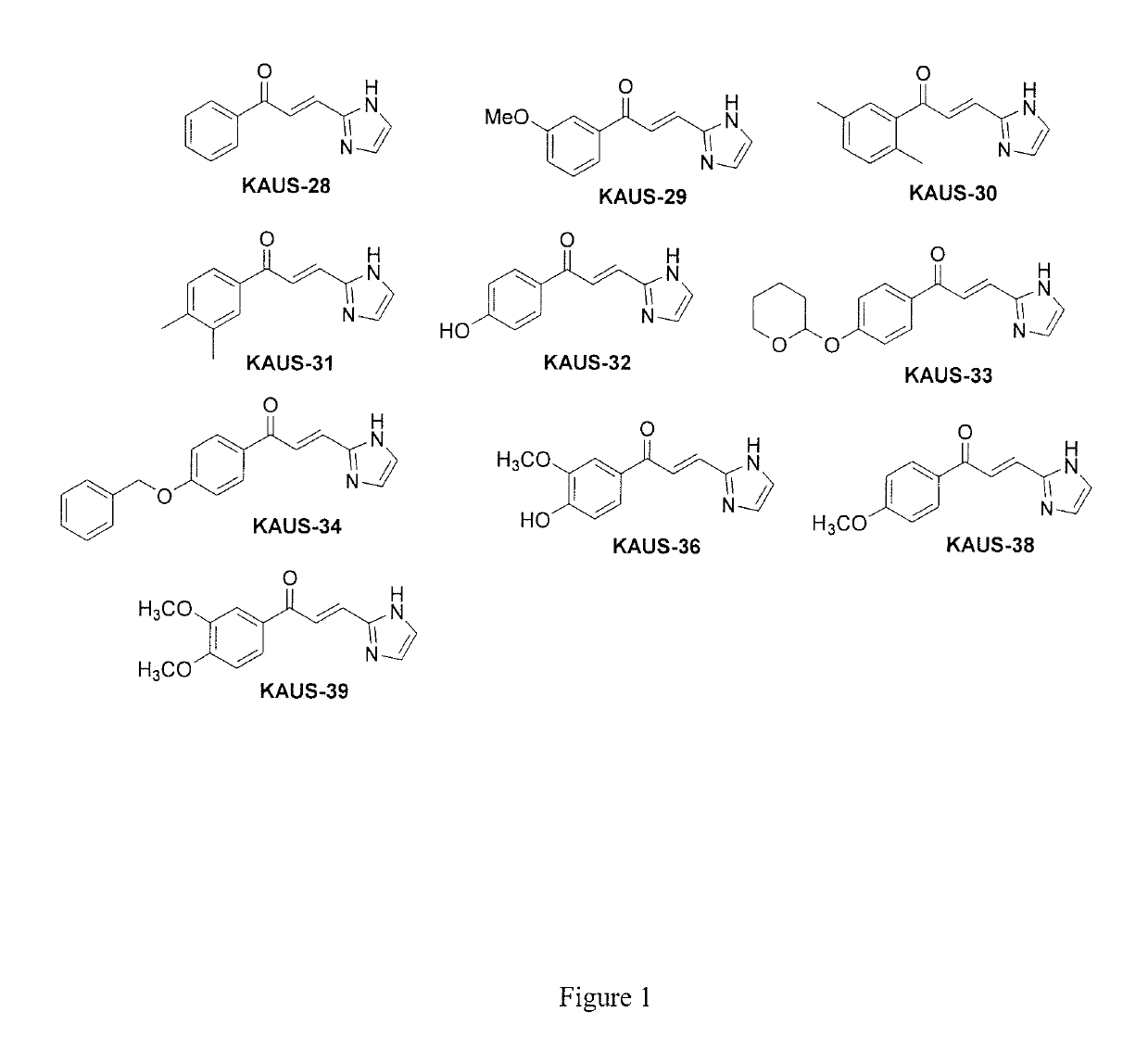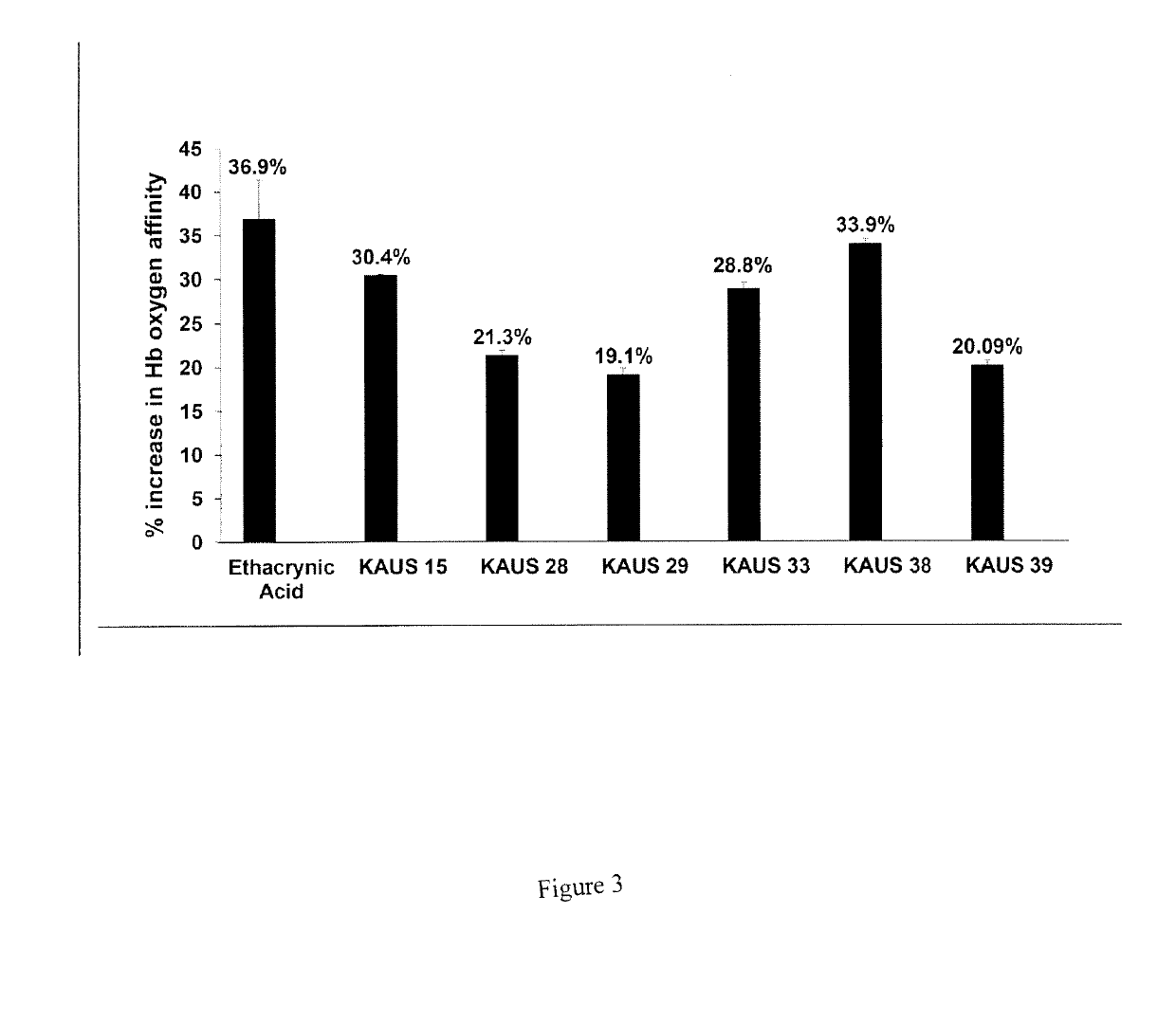Azolylacryloyl derivatives as therapeutic agents for sickle cell disease
a technology of azolylacryloyl and derivatives, which is applied in the field of azolylacryloyl derivatives as therapeutic agents for sickle cell disease, can solve the problems of extended therapeutic duration and not readily susceptible to metabolic destruction, and achieve the effects of preventing hypoxia-related polymerization, and increasing the affinity of protein oxygen
- Summary
- Abstract
- Description
- Claims
- Application Information
AI Technical Summary
Benefits of technology
Problems solved by technology
Method used
Image
Examples
example 1
d Synthesis of Azolylacryloyl Derivatives
[0073]Reagents and solvents for chemical synthesis were purchased from Sigma-Aldrich (USA) or Alfa Aeser (UK) or Acros Organics (Belgium) as ACS-reagent grade; and used without further purification. Anhydrous solvents were prepared according to standard methods.
[0074]Azolylacryloyl-carboxylate derivatives, e.g. KAUS-15 were previously designed to bind to βCys93 of Hb20, the intention being to allosterically increase Hb affinity for oxygen and thus prevent polymerization of sickle Hb and red blood cell sickling20. However, when tested, these compounds showed very weak allosteric and / or antisickling properties, with some of the compounds even exhibiting a pro-sickling effect20. Structural studies of the compounds showed that they undergo a Michael addition reaction with the N-terminal Val1 amine in the α-cleft of Hb but not with βCys93 of Hb as anticipated20. The binding to the α-cleft of deoxygenated Hb led to stabilization of the T-state Hb d...
example 2
y of KAUS Compounds Toward Free Amino Acid, L-Cysteine
[0090]The above synthesized KAUS compounds were expected to covalently bind to Hb through a Michael addition reaction with the βCys93 at the surface of the protein to effect their allosteric and antisickling activities. We therefore investigated L-Cys conjugates with KAUS-28, KAUS-29, KAUS-33, KAUS-38 and KAUS-39 with ECA as a positive control using UPLC-MS analysis as previously described20 with an Acquity H-Class UPLC which is connected to a PDA detector and an Acquity TQD detector. The column used was an Acquity UPLC BEH C18 1.7 μm, 2.1×50 mm, with a Vanguard pre-column attached. Solvent A consisted of water with 0.02% formic acid, while solvent B consisted of 90:10 acetonitrile:water with 0.02% formic acid. A gradient run was performed such that solvent B was increased from 0% B to 100% B from time 0-5 mins, followed by 3 minute wash at 100% B and then a return and re-equilibration at 100% A in the next 4 mins. The flow rate ...
example 3
uilibrium Curve (OEC) Studies
[0093]De-identified, leftover EDTA venous blood samples from patients with SCD who visited The Children's Hospital of Philadelphia for routine clinic visits, were obtained after informed consent and used for antisickling study. Normal whole blood was collected from adult donors at the Virginia Commonwealth University after informed consent and used for oxygen equilibrium curve study. Hb was purified from discarded normal blood samples following published procedure and used for OEC study34. The use of these human samples is in accordance with regulations of the IRB for Protection of Human Subjects.
[0094]The ability of the KAUS compounds to left-shift the OEC (stabilize the R-state and / or destabilize the T-state) and increase the oxygen affinity of Hb in normal whole blood or free human hemoglobin was determined by multipoint tonometry as previously reported20. First, cell free normal human hemoglobin (1 mM) or normal whole blood (hematocrit of 20%) was in...
PUM
| Property | Measurement | Unit |
|---|---|---|
| flow rate | aaaaa | aaaaa |
| temperature | aaaaa | aaaaa |
| temperature | aaaaa | aaaaa |
Abstract
Description
Claims
Application Information
 Login to View More
Login to View More - R&D
- Intellectual Property
- Life Sciences
- Materials
- Tech Scout
- Unparalleled Data Quality
- Higher Quality Content
- 60% Fewer Hallucinations
Browse by: Latest US Patents, China's latest patents, Technical Efficacy Thesaurus, Application Domain, Technology Topic, Popular Technical Reports.
© 2025 PatSnap. All rights reserved.Legal|Privacy policy|Modern Slavery Act Transparency Statement|Sitemap|About US| Contact US: help@patsnap.com



